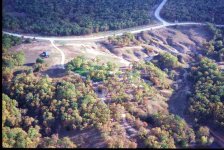Like have_blue said, sand is an excellent filter. I'm not technical enough to know about mineral content, but, after ofver 30 years of observing Florida ponds in an empiri cal sense, I'm also not worried about it. I've never heard of a pond turning salty, so I supect what we have is just plain ol' water (which, of course, always has some mineral content).
Yes, the trees and such do love it. You can tell where there is often standing water or where the water table is very high for long periods - red maples, cypress, and other trees like to grow where there's a lot of water, and live oak, slash pine, etc., like it a bit dryer - maybe 6"-12" higher in elevation /forums/images/graemlins/grin.gif
As for septic fields, yes, the are very strict about that, but it's no an undue hazard. The minimum distance is 75'. I've got the pond about 100' from the approved location for the tank. and further than that for the drain field. It's just a standard old perforated pipe drainfield - the work exceptionally well here, again, because that sand is such an excellent filter.
Essentially, what they want you to have is about 18" to 30" minimum average distance for the waste to permeate before it hits the water table. In my case, my permit requires me to build up the elevation 9" above the current elevation, then lay the pipe on top of that and bury it - resulting in approximately a 3' or so mound. At the time they checked, they tried to take a core sample to about 6', but they hit water at about 32".
They know longer do perc tests in my area - they just take a core sample, look to see what kind of soil is there (sand is good, hard pan is bad), and they'll know from there how it will percolate.
Yes, the trees and such do love it. You can tell where there is often standing water or where the water table is very high for long periods - red maples, cypress, and other trees like to grow where there's a lot of water, and live oak, slash pine, etc., like it a bit dryer - maybe 6"-12" higher in elevation /forums/images/graemlins/grin.gif
As for septic fields, yes, the are very strict about that, but it's no an undue hazard. The minimum distance is 75'. I've got the pond about 100' from the approved location for the tank. and further than that for the drain field. It's just a standard old perforated pipe drainfield - the work exceptionally well here, again, because that sand is such an excellent filter.
Essentially, what they want you to have is about 18" to 30" minimum average distance for the waste to permeate before it hits the water table. In my case, my permit requires me to build up the elevation 9" above the current elevation, then lay the pipe on top of that and bury it - resulting in approximately a 3' or so mound. At the time they checked, they tried to take a core sample to about 6', but they hit water at about 32".
They know longer do perc tests in my area - they just take a core sample, look to see what kind of soil is there (sand is good, hard pan is bad), and they'll know from there how it will percolate.
